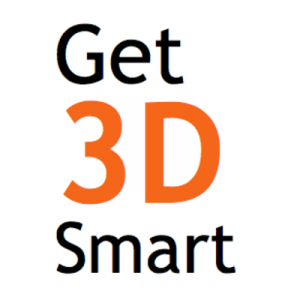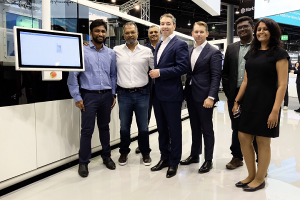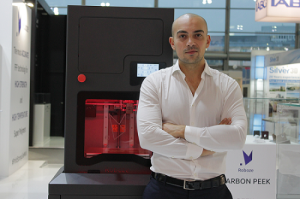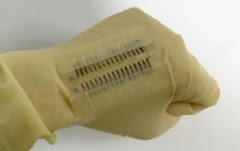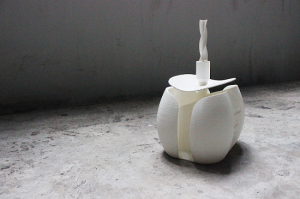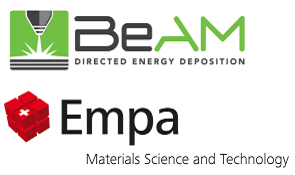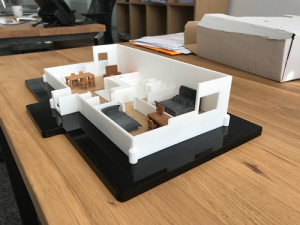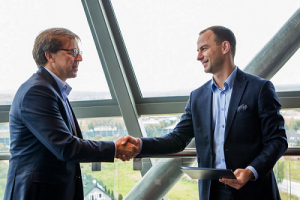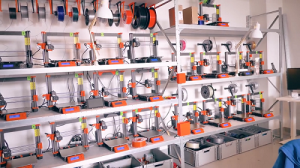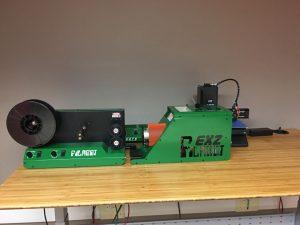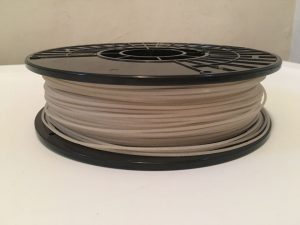John Hauer has founded and launched several tech-related businesses. In 2013, he co-founded and served as CEO of 3DLT. The company provided a platform for 3D printing as-a-service, helping Amazon, Walmart and other global retailers sell digitally manufactured products, online and in-store. In 2015, he founded Get3DSmart, a consulting practice which helps companies innovate with 3D printing and other related technologies.
Give us some background on how you’ve gotten to this point.
I spent 25 years in the 2d printing industry I worked for Xerox and several large commercial printers. I was involved in that industry up until about 2012. In 2012, I was at the 2d printing industry’s biggest trade show and the writing was literally on the wall. Books, magazines, newspapers, and direct Mail were all dead or dying. I spent 25 years in the 2d printing industry I worked for Xerox several large commercial printers and following that was involved in that industry up until about 2012. In 2012, I was at the 2D printing industry’s biggest trade show and the writing was literally on the wall. Books, magazines, newspapers, and direct mail were all dead or dying at that time. I started to wonder if maybe 3D printing was the future for the 2D printing industry because staples had just announced they were going to start putting m-core printers in the Netherlands and Belgium and there was some signs attraction so I started a blog called 3D for printers and began evangelizing 3D printing to 2D printing companies. It culminated with the first article that I wrote for TechCrunch about why 2d printing and 3d printing really are a lot alike. There was a lot of people at that time saying you can’t call it printing because it’s not printing. It’s not the same, but essentially the workflow is the same. A file gets created something gets sent to a device. It gets manufactured. It gets post processed or finished and then it gets shipped. So the workflow is pretty much the same. Some fellow Cincinnatians saw that and convinced me to start a business called 3DLT. We began as the first for-pay file marketplace in the United States and then we pivoted our business to become a platform for 3D printing as a service.
We worked with global retailers like Amazon, Walmart, Sears and others to help them sell 3d printed products online and in-store. We were the first to launch with Amazon and Walmart. We did it practically at the same time and it was right after we left an accelerator in Northern Kentucky called Up Tech. On that day we announced our partnership with Amazon.
We were featured in 250 press outlets in one day and I did my first national TV appearance on Fox Business. We got some amazing traction and started to take off. The business was venture funded and you know we were trying to build something really big and that takes a lot of money. It’s hard to do in the Midwest when 11 of the 20 billion dollars in venture capital is all coming out of Silicon Valley. So we were still able to do it and move forward. By about 2015, I had clients that were coming to me and asking me to help them with things that were related to 3D printing but weren’t in the retail space. I started a consulting practice called get 3d smart and began working with those clients by the end of 2015.That consultancy was self sufficient and I had a choice to make. I could continue you know working with this big opportunity at 3d LT which is probably a little early, in retrospect from a time perspective, or I could go and do the consulting thing and kind run my own show and you know control my own destiny. So I made a choice to exit 3DLT in December of 2015 and begin working at Get 3D Smart full time. Get 3D Smart helps clients identify and capitalize on opportunities in 3D Printing. Typically we do that from a marketing perspective. We do a lot of market assessments for our clients, helping them figure out which verticals and which segments of the industry they want to play in. Then we help them craft their strategy and communicate their strategy internally and externally. That can include everything from training sessions for their sales reps on different vertical markets, to white papers case studies interviews. As I mentioned before I write for several publications; Forbes, TechCrunch, 3D print, and a host of others.
What initially got you interested in tech journalism in particular?
I’ve been blogging and writing for 15 years now and I write about all kinds of emerging technologies. I wrote a series for Forbes about IOT. I write about artificial intelligence,automation, virtual reality, and all of those are of interest to me mostly because they are platform type technologies. They can drive the development of many different types of new businesses, and I’m especially intrigued when people combine one or more of those platform technologies. I wrote an article about this for Futurism how when you look at things like artificial intelligence and 3D printing, or virtual reality and artificial intelligence, or IOT and 3D printing, and you start to look at those technologies and combine them, it creates all kinds of new but interesting business opportunities. That is what’s most fascinating to me. How do you take some of those very disruptive platform technologies and bring them together to create a new business model?
In general, why are you interested in 3D printing?
I come from a background of having been involved in digitization. When I started for Xerox in 1990, digital printing was just coming on the scene. It was a whole new world for people. There was no functional internet. All the things you take for granted in printing today like PDF and all those things, none of that existed. It had to be created, and I watched the market grow from being a small cottage industry within a really big industry. Digital was tiny and the overall print industry to a point. Now we’re here thirty years later. In some cases it represents 50 percent of the market share, and it depends on what side of the market you’re in. Digital is pervasive and one of the other things that we saw about it was the breakeven of when it made sense to use digital technologies versus when it made sense to use analog technologies continue to shift inward. When Xerox brought out one of their first digital color copiers it printed five pages a minute, blue looked like purple, and it cost five dollars a page. Everybody said there’s no way it’s going to be successful; No one’s gonna pay that kind of price yet. They did because they could have one of whatever they wanted. They didn’t need five thousand, ten thousand, or a hundred thousand. They could get one. 3D printing is doing that today, What digital printing eventually did is have a breakeven that went from five to fifty to five hundred to five thousand. HP has wide format inkjet presses that can compete with analog technologies that a half a million units or more we’re seeing the same thing happening in 3D printing already. HP just announced that it had printed its 10 millionth part off of their technology. That might seem like a lot, but in reality there’s some build boxes that might have a thousand or more parts in them so it’s not a huge endeavor to get to ten million parts. It is a harbinger of things to come when you look at what’s happening now. The breakeven for a product might have been fifty pieces. Now it’s 500 and with that next evolution maybe the 5200 series or whatever comes after. Maybe whatever Carbon brings to the table or you or any of the other manufacturers, we now get to 50,000 and that’s when it gets really interesting but that’s not the only reason 3d printing is compelling. It’s not just a price issue. Sometimes it’s personalization and customization. Sometimes it’s the ability to manufacture on demand like I talked about before. Sometimes it’s about speed to market and being able to get a product to market before any others. Before you could in any other way and if you’re talking about marketing in the moment that stuff is critical so all of those things were interesting for me in part because I saw the parallels to 2d printing, and in part because I know those use cases. Those scenarios where there’s a value add, there’s a significant opportunity to go out and build an industry, and for 30 years 3d printing was a cottage industry. Now all of a sudden that’s on the cusp of going mainstream, and it took big players like HP, Carbon, Desktop Metal GE, and others to help make that possible. Now that they’re here it’s game on.
How has journalism helped you in your entrepreneurial career?
It’s been great. I mean it’s forces me to soak in more knowledge to become an expert in areas that I wasn’t in the past you know because you start you come up with a concept and you say okay now I have to dig deep and understand what this industry really means. I have the research at my disposal to be able to talk intelligently about it. That’s one side of it, and then the other side of it is it’s just from a marketing perspective it’s been fantastic. It’s helped me build the name recognition and thought leadership that I want in the industry as kind of an outsider. My tag is that I’m a gonzo technology journalist. Hunter Thompson is one of my favorite journalists of all time. I love that approach. I want to take a different slant at it, and you know maybe it’s gonna ruffle some feathers along the way, but that’s alright. You can’t try to please everybody you’re probably not doing it right so journalism has been great for me for both perspectives it’s helped me become smarter and knowledgeable about topics within our industry but also it’s been a great marketing tool.
What are some big trends in 3D printing media that you are kind of looking out for in the media or with 3D printing in general in the media?
That’s a good question. The problem with 3d printing is it goes through hype cycles right, and we went through that and call it 2009 through 2012 and then maybe again over the last couple years like 14 to 16, where it gets the attention and hype of the mainstream press. Then it goes into a lull where it’s not quite as covered maybe as it would have been and then you know it goes back into one of these hype cycles again. I think we’re probably hitting a little bit of a lull to some degree with mainstream media, but that’s okay because you know what’s happened is there’s been a big shift in 3D printing from this concept that everybody was going to have a 3d printer in their home and make everything that they wanted to ever need to back to this is more of an industrial and commercial opportunity where it’s going to impact consumers because they’re going to be able to get better products faster and potentially less expensively. They’re not going to manufacture them in their home and that’s just not as glamorous to the mainstream media. Maybe you know it’s very important to industrial publications and trade publications and you know that kind of thing but it’s just not glamorous to Forbes in a Wall Street Journal and those kinds of publications and you know. I think it’s going to be that way for a long time even if 3D printing in the home becomes ubiquitous like inkjet printing where everybody has one. It’ll probably follow the same model. Less than 10% of all the pages produced are produced on those devices. The vast majority are printed for pay by somebody else, and the likeliness is that in 3D printing the same thing will happen now. Who that is and where and how are all up for debate but that’s the sign of a growing and big market. I mean look at how HP just did a deal with Smile Direct for 50 machines and that was big. Somebody made a lot of money on that deal and there are going to be orders that are five times that size as this market continues to grow. When you’re selling an order of five million or ten million dollars a pop that starts to build some scale pretty quickly. Even more than 50 million or 100 million versus you know small desktop printer, it’s just not the model that’s gonna work.
Customization is pretty cool it when it comes to 3D printing – what are you thoughts on specific industries that can really benefit from customization?
The medical industry certainly has been the leader in that charge so far. When you look at the hearing aid business or you look at dental aligners or you look at prosthetics or orthotics, all of those have been what I would tag as killer applications so far out of the gate. Almost every one of them relies heavily on customization and personalization but you know there are plenty of other consumer products that are going to be a big. Automotive has a lot of potential. There are other markets where customization and personalization is gonna play. One value add people think of when they get a new technology a new digital technology like this is on-demand manufacturing. I firmly believe and I’ve written about this a lot, that speed to market is probably the bigger opportunity in the end. It doesn’t even matter whether or not it’s competitive with what you’re gonna pay to mass-produce something it’s a matter of how fast you can get it to market and if there’s any kind of sensitivity around timing whatsoever either a competitive environment or you know it’s marketing in the moment there’s some trend you’re trying to hit right now. I think speed to market is probably the one that drives the greatest growth and end-use production parts. There is always friction when you’re attempting to customize or personalize.



